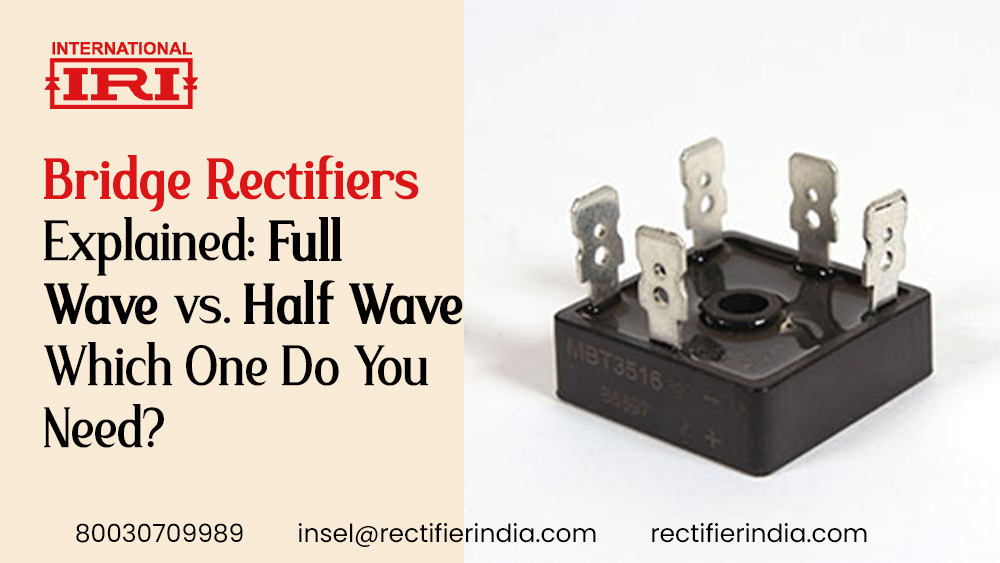Bridge Rectifiers Explained: Full Wave vs. Half Wave – Which One Do You Need?
Bridge rectifiers convert AC to DC power, with half-wave and full-wave types serving different efficiency and application needs. Understanding their differences aids in selecting the right rectifier for your project.

In electronics, rectifiers play a crucial role in converting AC (Alternating Current) into DC (Direct Current). The full wave bridge rectifier and half wave bridge rectifier are the most commonly used among the different types. Choosing the right rectifier depends on the specific power requirements of an application. Many industries rely on trusted bridge rectifier manufacturers to supply high-quality components for efficient power conversion. Understanding the differences between these rectifiers can help determine the most suitable option for different projects.
What is a Bridge Rectifier?
A bridge rectifier is an electrical circuit designed to convert AC into DC using a configuration of diodes arranged in a bridge formation. This ensures efficient power conversion and provides a smoother DC output. Bridge rectifiers are widely used in power supplies, battery chargers, and various electronic applications that require stable DC power. The two primary types of bridge rectifiers are half wave bridge rectifiers and full wave bridge rectifiers. Each serves a distinct purpose based on power needs and efficiency requirements.
Half Wave Bridge Rectifier – A Basic and Cost-Effective Solution
A half wave bridge rectifier is the simplest type of rectifier, utilizing a single diode to allow only one half of the AC cycle to pass through while blocking the other half.
How It Works
During the positive half-cycle of AC input, the diode conducts and allows current to flow, producing a DC output.
During the negative half-cycle, the diode blocks the current, creating interruptions in the output.
Advantages of a Half Wave Bridge Rectifier
· Simpler design – Requires minimal components.
· Cost-effective – A practical choice for low-power applications.
· Easy to implement – Common in small electronic circuits.
Limitations of a Half Wave Bridge Rectifier
· Lower efficiency – Only utilizes half of the AC input.
· Higher ripple factor – Produces an unstable DC output, often requiring additional filtering.
· Limited power handling – Not suitable for high-power applications.
Applications of a Half Wave Bridge Rectifier
Due to its limitations, the half wave bridge rectifier is primarily used in:
· Small battery chargers
· Signal demodulation circuits
· Basic power supply circuits for low-demand devices
For projects requiring only minimal DC power, a half wave bridge rectifier serves as an economical and straightforward solution.
Full Wave Bridge Rectifier – Efficient & Reliable Power Conversion
A full wave bridge rectifier is more advanced and efficient, using four diodes in a bridge configuration to convert both halves of the AC cycle into DC output.
How It Works
During the positive half-cycle, two of the four diodes conduct, allowing current to flow through the circuit.
During the negative half-cycle, the other two diodes conduct, ensuring continuous current flow in the same direction.
This setup results in a more stable and efficient DC output.
Advantages of a Full Wave Bridge Rectifier
· Higher efficiency – Utilizes both halves of the AC cycle.
· Lower ripple factor – Produces a more consistent DC output.
· Better power utilization – Suitable for high-power applications.
Limitations of a Full Wave Bridge Rectifier
· More complex design – Requires additional components compared to a half wave rectifier.
· Higher cost – More components lead to a slightly higher expense.
Applications of a Full Wave Bridge Rectifier
The full wave bridge rectifier is widely used in applications requiring stable and efficient DC power:
· Industrial power supplies
· LED lighting systems
· Battery charging circuits
· Home and commercial appliances
For applications requiring consistent and reliable power conversion, a full wave bridge rectifier is often the preferred choice.
Choosing Between a Half Wave and a Full Wave Bridge Rectifier
The decision between a half wave bridge rectifier and a full wave bridge rectifier depends on power requirements, efficiency, and cost considerations.
For low-power applications where simplicity and affordability are key, a half wave bridge rectifier may be sufficient.
For higher efficiency and better performance, especially in industrial and commercial applications, a full wave bridge rectifier is the ideal choice.
Selecting a Reliable Bridge Rectifier Manufacturer
When sourcing bridge rectifiers, it is important to choose a reliable manufacturer that provides high-quality components designed for efficiency and durability. Key factors to consider when selecting a bridge rectifier manufacturer include:
· High-quality diode construction for optimal performance.
· Various rectifier options suited for different voltage and current ratings.
· Industry-standard designs that meet diverse application requirements.
Find the Right Bridge Rectifiers for Your Needs
Whether for low-power circuits or high-efficiency power supply systems, selecting the correct bridge rectifier ensures stable and effective power conversion. A reputable bridge rectifier manufacturer can provide the right solution based on specific application demands.






